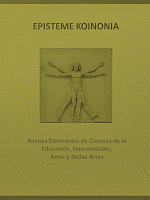Speech enhancement through information gap filling technique
DOI:
https://doi.org/10.35381/e.k.v5i9.1664Palabras clave:
Speech education, second language instruction, language instruction. (UNESCO Thesaurus).Resumen
This study investigates English language use with classroom students after applying the Information Gap Filling Technique (IGT) at the Paiguara public school in San Juan-Gualaceo, Ecuador. A sample of 22 students (12 boys and 10 girls) from the third level of BGU was selected. The research was conducted in two phases. The quantitative part used a pre- and post-test of oral interaction and in the qualitative part, a questionnaire with open-ended questions. The findings of the study showed that students increased their use of English in the classroom as a result of the application of IGT in the variables of comprehension, grammar, vocabulary, fluency and pronunciation with values of (0.37, 0.50, 0.27, 0.05, 0.32) respectively. Consequently, the Information Gap-filling technique has proved to be effective in promoting the use of English language in classrooms as a means of communication.
Descargas
Citas
Almziad, A., Arsahd, A. S., Bakar, R., & Lilliati, I. (2020). Using information gap activities to improve the speaking skills of Saudi Arabian introverted and extroverted learners. PalArch’s Journal of Archaeology of Egypt / Egyptology, 17(6), 357 - 368. Retrieved from https://archives.palarch.nl/index.php/jae/article/view/725
Atek, E., Hassan, I., Azmi, M., Yah, M., & Azmi, N. (2020). Popular Approaches to the Teaching of English Literature among Students in Selected Malaysian Secondary Schools. International Journal of English Language and Literature Studies, 9(4), 339-348. doi:https://doi.org/10.18488/journal.23.2020.94.339.348
Burns, A., & Joyce, H. (1997). Focus on Speaking. North Ryde, Sydney: National Centre for English Language Teaching and Research. Retrieved from https://n9.cl/uk2pi
Chan, K. K., & Tang, W. K. (2022). Radio Drama Competition as an Effective Tool to Boost the Motivation and Self-Confidence of Primary and Secondary School English Learners in Hong Kong. English Language Teaching, 15(1), 154-163. doi:10.5539/elt.v15n1p154
Creswell, J. W. (2021). Educational research : planning, conducting, and evaluating quantitative and qualitative research (Sixth, global edition). Harlow, England: Pearson Education Limited.
Cronquist, K., & Fiszbein, A. (2017). English Language Learning in Latin America. The Dialogue, 8-19. Retrieved from https://n9.cl/l6m43
Dabaghmanesh, T., Zamanian, M., & Sadegh Bagheri, M. (2013). The Effect of Cooperative Learning Approach on Iranian EFL Students" Achievement among Different Majors in General English Course. International Journal of Linguistics, 5(6). doi:10.5296/ijl.v5i6.46
De Wilde, V., Brysbaert, M., & Eyckmans, J. (2020). Learning English through out-of-school exposure : which levels of language proficiency are attained and which types of input are important? Bilingualism-Language and Cognition, 23(1), 171-185. Retrieved from https://doi.org/10.1017/s1366728918001062
Defrioka, A. (2017). The use of information gap activities in teaching speaking (Classroom Action Research at SMK). Lingua Didaktika. Journal Bahasa dan Pembelajaran Bahasa, 10(2), 116-126. doi:10.24036/ld.v10i2.6418
Defriota, A. (2017). The use of Information gap activities in teaching speaking. Lingua Didaktika Jurnal Bahasa dan Pembelajaran Bahasa, 10(2), 116-126. doi:10.24036/ld.v10i2.6418
Eddie, A., & Aziz, A. (2020). Developing Primary Students' Spoken Interaction Skill through Communicative Language Teaching. International Journal of Academic Research in Business and Social Science, 10(2), 303-315. doi:10.6007/IJARBSS/v10-i/6931.
Eun, B. (2019). The Zone of Proximal Development an Overarching Concept: A Framework for Synthesizing Vygotsky's Theories. Educational Philosophy and Theory, 51(1), 18-30. doi:10.1080/00131857.2017.1421941
Harmer, J. (2016). The Practice of English Language Teaching (5 ed.). The United Kingdom: Pearson Longman.
Hayes, A., & Coutts, J. (2020). Use Omega Rather than Cronbach's Alpha for stimating Reliability. But.... Communication Methods and Measures, 14, 1-24. doi:10.1080/19312458.2020.1718629
Krashen, S. (1982). Principles and Practice in Second Language Acquisition. 1st ed. Oxford: New York: Pergamon.
Lado, R. (1964). Language Teaching: A Scientific Approach. London, UK: McGraw-Hill.
Laelasari, E. (2018). Improving student's speaking skills in asking and giving information by using information gap. 7 (9). Retrieved from https://n9.cl/044co
Namaziandost, E., Saray, A. A., & Esfahani, F. (2018). The Effect of Writing Practice on Improving Speaking Skill among Pre-intermediate EFL Learners. Theory and Practice in Language Studies, 8(12), 1690-1697. http://dx.doi.org/10.17507/tpls.0812.16
Ohta, A. (2013). Sociocultural theory and the zone of proximal development. Cambridge: Cambridge University Press. doi: https://doi.org/10.1017/CBO9781139051729
Prabawa, W. (2016). Speaking strategies used by Indonesian tertiary students. English Review Journal of English Education, 231-242. doi:https://doi.org/10.25134/erjee.v4i2.337
QuestionPro. (2022). Open Ended Questions: Definition, Characteristics, Examples, and Advantages [Blog]. Retrieved from https://n9.cl/wg86l
Savaşçı, M. (2014). Why Are Some Students Reluctant To Use L2 in EFL Speaking Classes? An Action Research at Tertiary Level. Procedia-Social and Behavioral Sciences, 116, 2682-2686. doi:10.1016/j.sbspro.2014.01.635.
Shatalebi, V., Nasri, M., & Namaziandost, E. (2019). The impact of Cooperative Learning on Developing Speaking Ability and motivation toward Learning English. Journal of Language and Education, 5(3), 83-101. doi:10.17323/jle.2019.9809.
Soleimani, H., & Khosravi, A. G. (2018). The Effect of Kagan's Cooperative Structures on Speaking Skill of Iranian EFL Learners. International Journal of English Language & Translation Studies, 1, 20-31. Retrieved from https://n9.cl/6ya7h
Syakur, A., Margana, S., Junining, E., & Sabat, Y. (2020). Improving English Language Speaking Skills Using 'Absayak' On-line Learning Model for Second Semester in Higher Education. BirLE-Journal, 3(2), 684-694. doi:10.33258/birle.v3i2.897.
Vigotsky, L. (1962). Thought and Language. Cambridge: M.I.T. Press.
Ward, A. E., Bidyut, J. B., & Jackson, N. (2016). The Assessment of Engineering Student Public Speaking Ability: What, How and Issues. International Conference on Engineering Education and Research. Retrieved from https://n9.cl/y0q71
Publicado
Cómo citar
Número
Sección
Licencia
CC BY-NC-SA : Esta licencia permite a los reutilizadores distribuir, remezclar, adaptar y construir sobre el material en cualquier medio o formato solo con fines no comerciales, y solo siempre y cuando se dé la atribución al creador. Si remezcla, adapta o construye sobre el material, debe licenciar el material modificado bajo términos idénticos.
OAI-PMH URL: https://fundacionkoinonia.com.ve/ojs/index.php/epistemekoinonia/oai







